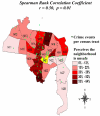Perceived neighborhood safety and incident mobility disability among elders: the hazards of poverty
- PMID: 19476610
- PMCID: PMC2693137
- DOI: 10.1186/1471-2458-9-162
Perceived neighborhood safety and incident mobility disability among elders: the hazards of poverty
Abstract
Background: We investigated whether lack of perceived neighborhood safety due to crime, or living in high crime neighborhoods was associated with incident mobility disability in elderly populations. We hypothesized that low-income elders and elders at retirement age (65 - 74) would be at greatest risk of mobility disability onset in the face of perceived or measured crime-related safety hazards.
Methods: We conducted the study in the New Haven Established Populations for Epidemiologic Studies of the Elderly (EPESE), a longitudinal cohort study of community-dwelling elders aged 65 and older who were residents of New Haven, Connecticut in 1982. Elders were interviewed beginning in 1982 to assess mobility (ability to climb stairs and walk a half mile), perceptions of their neighborhood safety due to crime, annual household income, lifestyle characteristics (smoking, alcohol use, physical activity), and the presence of chronic co-morbid conditions. Additionally, we collected baseline data on neighborhood crime events from the New Haven Register newspaper in 1982 to measure local area crime rates at the census tract level.
Results: At baseline in 1982, 1,884 elders were without mobility disability. After 8 years of follow-up, perceiving safety hazards was associated with increased risk of mobility disability among elders at retirement age whose incomes were below the federal poverty line (HR 1.56, 95% CI 1.02 - 2.37). No effect of perceived safety hazards was found among elders at retirement age whose incomes were above the poverty line. No effect of living in neighborhoods with high crime rates (measured by newspaper reports) was found in any sub-group.
Conclusion: Perceiving a safety hazard due to neighborhood crime was associated with increased risk of incident mobility disability among impoverished elders near retirement age. Consistent with prior literature, retirement age appears to be a vulnerable period with respect to the effect of neighborhood conditions on elder health. Community violence prevention activities should address perceived safety among vulnerable populations, such as low-income elders at retirement age, to reduce future risks of mobility disability.
Figures


Similar articles
-
Neighborhood support network, perceived proximity to community facilities and depressive symptoms among low socioeconomic status Chinese elders.Aging Ment Health. 2016;20(4):423-31. doi: 10.1080/13607863.2015.1018867. Epub 2015 Mar 16. Aging Ment Health. 2016. PMID: 25775108
-
Multilevel Associations of Neighborhood Poverty, Crime, and Satisfaction With Blood Pressure in African-American Adults.Am J Hypertens. 2016 Jan;29(1):90-5. doi: 10.1093/ajh/hpv060. Epub 2015 Apr 27. Am J Hypertens. 2016. PMID: 25917562 Free PMC article. Clinical Trial.
-
Neighborhood effects on the self-rated health of elders: uncovering the relative importance of structural and service-related neighborhood environments.J Gerontol B Psychol Sci Soc Sci. 2006 May;61(3):S153-60. doi: 10.1093/geronb/61.3.s153. J Gerontol B Psychol Sci Soc Sci. 2006. PMID: 16670193
-
Neighborhood sexual violence moderates women's perceived safety in urban neighborhoods.J Community Psychol. 2018 Jan;46(1):79-94. doi: 10.1002/jcop.21917. Epub 2017 Oct 12. J Community Psychol. 2018. PMID: 30104801 Free PMC article.
-
One size doesn't fit all: cross-sectional associations between neighborhood walkability, crime and physical activity depends on age and sex of residents.BMC Public Health. 2017 Jan 19;17(1):97. doi: 10.1186/s12889-016-3959-z. BMC Public Health. 2017. PMID: 28103842 Free PMC article.
Cited by
-
Mobility and aging: new directions for public health action.Am J Public Health. 2012 Aug;102(8):1508-15. doi: 10.2105/AJPH.2011.300631. Epub 2012 Jun 14. Am J Public Health. 2012. PMID: 22698013 Free PMC article. Review.
-
A Genetically Informed Study of Neighborhoods and Health: Results From the MIDUS Twin Sample.J Gerontol B Psychol Sci Soc Sci. 2020 Apr 16;75(5):1072-1081. doi: 10.1093/geronb/gby157. J Gerontol B Psychol Sci Soc Sci. 2020. PMID: 30597101 Free PMC article.
-
[Disability status and robbery victimization in Peruvian villagers].Rev Esp Salud Publica. 2024 Mar 15;98:e202403022. Rev Esp Salud Publica. 2024. PMID: 38516902 Free PMC article. Spanish.
-
Does Religion Mitigate the Effect of Neighborhood Disorder on Cognitive Decline?: Evidence From a National Longitudinal Study of U.S. Older Adults.J Gerontol B Psychol Sci Soc Sci. 2024 Dec 1;79(12):gbae147. doi: 10.1093/geronb/gbae147. J Gerontol B Psychol Sci Soc Sci. 2024. PMID: 39180185 Free PMC article.
-
"Our Home Is a Muddy Structure": Perceptions of Housing and Health Risks Among Older Adults in Contrasting Neighborhoods in Ghana.Front Public Health. 2021 Apr 22;9:650861. doi: 10.3389/fpubh.2021.650861. eCollection 2021. Front Public Health. 2021. PMID: 33987164 Free PMC article.
References
-
- Centers for Disease Control and Prevention Public health and aging: trends in aging – United States and worldwide. MMWR. 2003;52:101–106. - PubMed
-
- Fried LP, Ferrucci L, Darer J, Williamson JD, Anderson G. Untangling the concepts of disability, frailty, and comorbidity: implications for improved targeting and care. J Gerontol A Biol Sci Med Sci. 2004;59:255–263. - PubMed
-
- Guralnik JM, LaCroix AZ, Abbott RD, Berkman LF, Satterfield S, Evans DA, Wallace RB. Maintaining mobility in late life. I. Demographic characteristics and chronic conditions. Am J Epidemiol. 1993;137:845–857. - PubMed
-
- Fried LP, Guralnik JM. Disability in older adults: evidence regarding significance, etiology, and risk. J Am Geriatr Soc. 1997;45:92–100. - PubMed
Publication types
MeSH terms
Grants and funding
LinkOut - more resources
Full Text Sources
Medical

